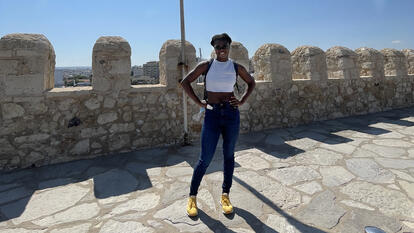Wellesley’s Daniela Rivera Explores Displacement and Environmental Destruction in Her Solo Exhibition at the Museum of Fine Arts in Boston

Visitors must look up—way up—to fully experience the works Daniela Rivera, associate professor of art at Wellesley, created for her solo exhibition, The Andes Inverted, at the Museum of Fine Arts, Boston. That choice was deliberate, said Rivera. She wants viewers to feel as if they are looking up at the sky from the bottom of Chuquicamata, one of the largest open pit copper mines in the world. Located in Rivera’s native Chile, Chuquicamata is wide enough to contain Central Park and is a counterpoint to the nearby soaring Andes Mountains.
“Chuquicamata was a symbol of national pride and a driver of the Chilean economy for decades,” said Rivera, who remembers visiting the state-owned mine during a class trip when she was in high school. The town at Chuquicamata’s edge had a world-class hospital, schools, theaters, sports fields, and homes for 30,000 people. Yet when the site became too contaminated, according to international standards, and the mine ran out of room to dump its detritus in 2008, the Chilean government decided it was cheaper to move the residents than the debris. Residents were forced to move to Calama, a city 15 kilometers away, and their former homes were buried under rock, “like a modern Pompeii,” Rivera said.
As the museum’s website explains, The Andes Inverted “evokes the paradox faced by Chuquicamata miners, many of whom described the jobs and joy provided by the state. Rivera explains the miners’ situation is not black-and-white but grey: ‘Their labor is both productive and destructive, the self-sabotage is the complexity of the place.’”
Rivera, whose work has been featured in venues across the United States and Latin America, returned to Chuquicamata and Calama in 2015, when she was a traveling fellow of the School of the Museum of Fine Arts. Initially, she thought she would focus just on the landscape and how it has been degraded, she said. Yet as she interviewed people about their experiences and losses, she decided she wanted to explore how the mine affected them culturally and psychologically—even disrupting their sense of stability and time.
“Being at the mine makes you lose your sense of place and gives you a sense of vertigo,” Rivera said. “And when I looked up at the sky, I realized that the horizon line, the surface of the earth, was the only sense of the present there. The mine and even the stars are manifestations of the past.”
Shortly after her trip, Rivera began designing pieces for The Andes Inverted, which opened March 4 and will continue through February 25, 2018. The exhibit features a five-tiered oil painting; a 37-by-20-foot copper-point drawing (the technique involves drawing with a small rod of copper) on a tilted wall; a sound art piece made in collaboration with Jenny Johnson, associate professor of music; and a video that includes a brief interview with a couple born and raised in Chuquicamata.
To connect her art to the place that inspired it, Rivera mixed soil from the mine into her oil paints, and she used rocks from the site to trace shapes in her copper-point drawing. She also installed all the components of the work at an angle, using scaffolding-like structures. The copper-point drawing is tilted toward the center of the gallery space; the video is projected at an angle and acts as a bridge connecting the spaces; and the paintings form a high vertical stack that leans back against the wall. As an article on Wellesley’s website notes, “These architectural interventions into the space of the museum recall the physical presence of the mine, and also its metaphorical presence in the lives and minds of those in residence around it.”
The Andes Inverted is Rivera’s largest and most ambitious installation to date, she said. Four Wellesley alumnae—all former students of Rivera’s—helped her create the massive copper-point drawing on the wall of the gallery space; the wall had been previously cut and tilted toward the center of the space and then primed. Rivera and her team had just five days to complete the project.
“At the outset of this endeavor, the five of us, including Daniela, were afraid we might not finish in our allotted time frame, but we were all prepared to work like crazy to make it happen,” said Catherine Harlow ’15, who wrote about the experience for the museum’s website. “Working alongside Daniela and fellow art student alumnae felt like going home to Wellesley, in a spiritual way.”
When the work was completed, just hours before the exhibition opened, the team was delighted by what they had accomplished and by the way the tilted artwork recreates the sense of disorientation people feel in the mine, said Rivera. The audio component, which plays continuously and constantly changes, reinforces that sense by randomly playing clips of miners’ voices, wind, and other sounds from the Atacama desert plus the compositions Johnson created for the piece.
“I always react to spaces as an artist,” said Rivera. “I wanted to create an experience for viewers that lets them feel what it’s like to be dislocated from their history and memories, and to lose identity. This project also allowed me to explore part of my own personal history.”
Daniela Rivera: The Andes Inverted at the Museum of Fine Arts, Boston.
March 8, 2017
Eunice and Julian Cohen Galleria
*Photograph © Museum of Fine Arts, Boston



